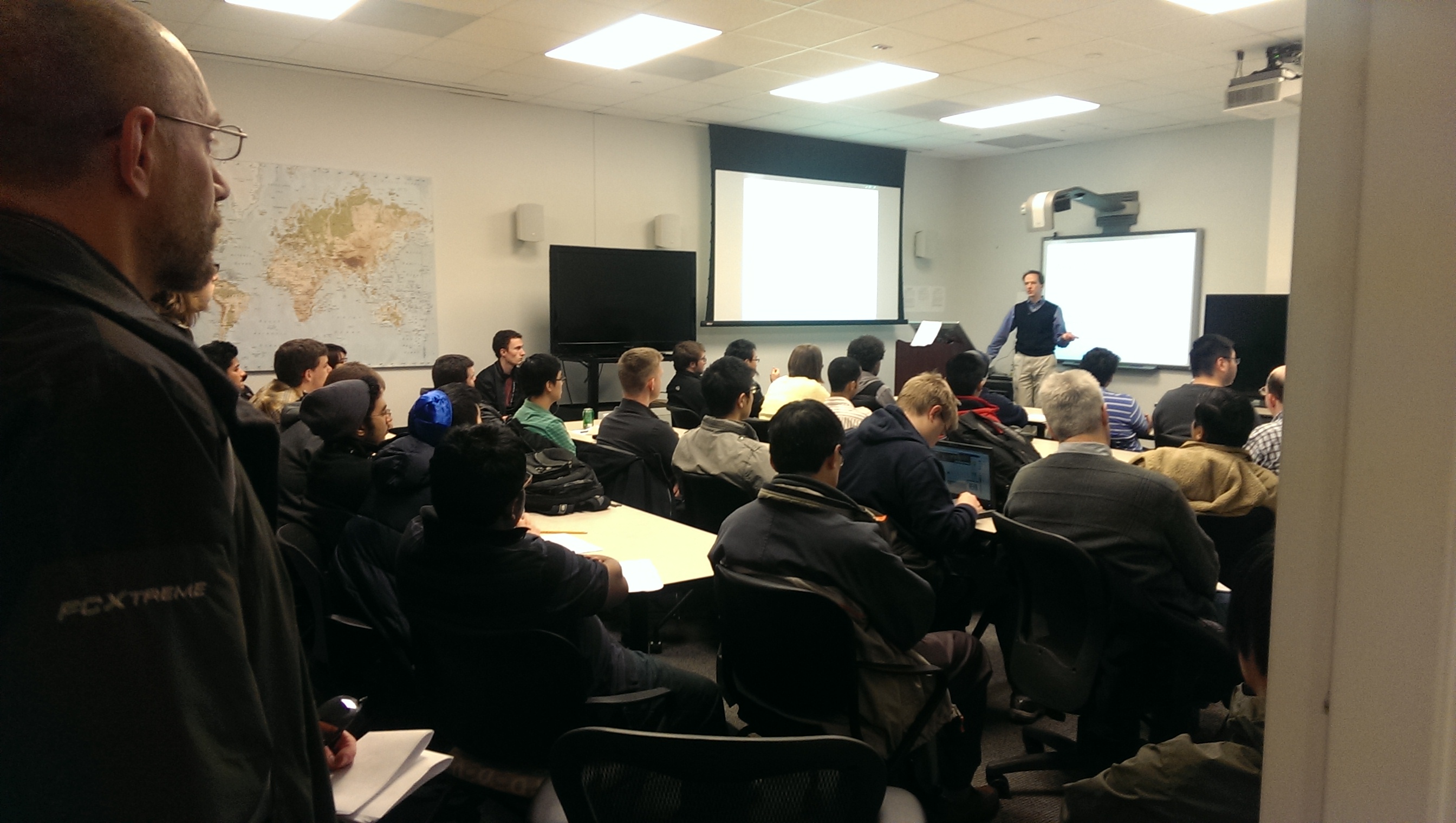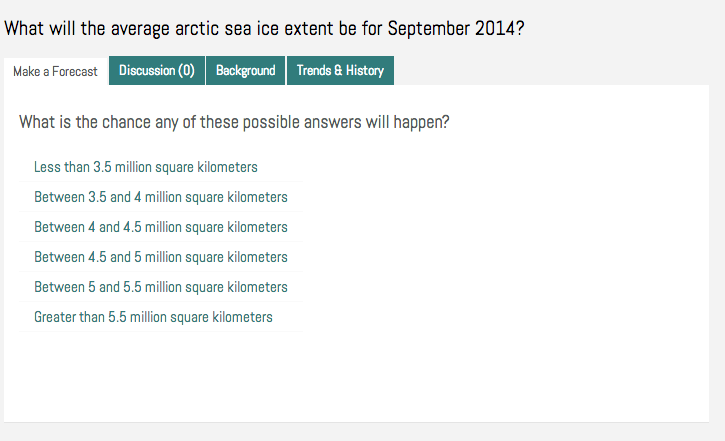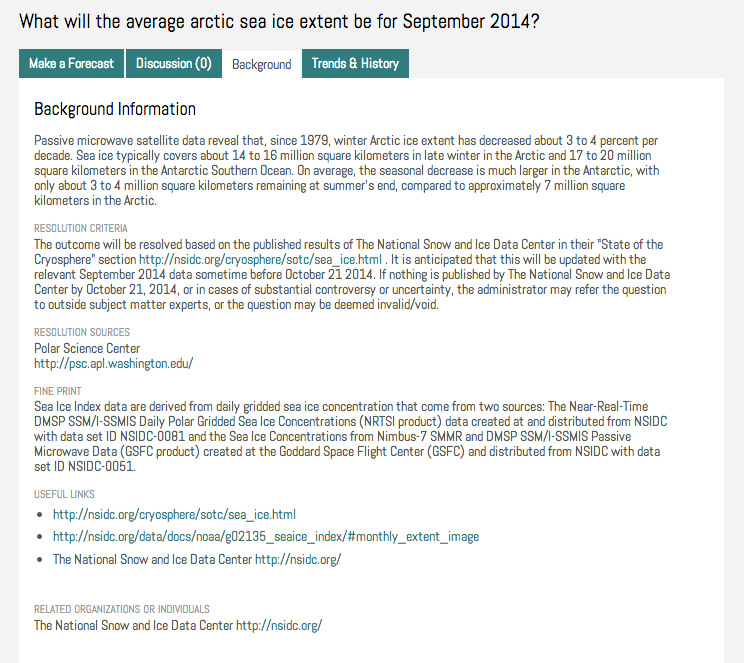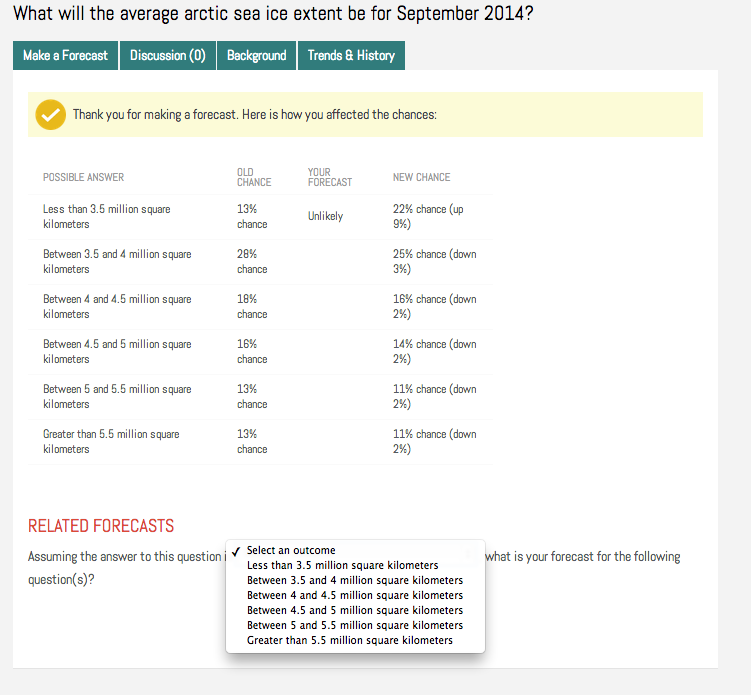We recently increased everyone’s assets, giving users an extra 4000 points and we started out new users with 5000 points. Read about it here.
Tag Archives: SciCast
Great Lakes questions have resolved
The Great Lakes questions have resolved.
Lake Ontario
What will be the peak mean ice concentration in Lake Ontario during the 2013/2014 winter? has resolved as “56% or greater”. Data from NOAA coastal watch indicates Lake Ontario ice concentration hit 61.52%.
Analysis of the Predictions
Our raw market Brier Score (before smoothing or adjustments) was .75.
We’ve Given Everyone More Points!
As the number of open questions on SciCast increases, some users are finding their points stretched too thin. We want our users to make forecasts when they have the interest and knowledge. To make this possible, we’re giving every registered user an extra 4000 points, and starting out all new users with 5000 points.
This change will not immediately affect any person’s rank on the leaderboard, though it might offer new opportunities to move up or down in the rankings. If you have run out of points or are extremely short on points, you now have the assets you need to make more forecasts. Please use these new assets and opportunities wisely. The overall accuracy of SciCast’s market forecasts is improving, and we all want to see a steady continuation of that trend.
Did you like this post? Follow us on Twitter.
User Activity (1st Quarter, 2014)
By March 31, SciCast had 5425 forecasts, 1375 users, and 444 questions.
The graph below (click to enlarge) shows some user activity statistics through the end of March. Registrations have leveled off, but the number of daily forecasts per active user is rising. Since January, the average number of forecasts per day among people who make comments and forecasts on SciCast questions has roughly doubled (from 2.5 to 5).
The number of registered users has increased over the same time frame, but most registration occurred early in the year. We had about 800 new users in January but only about 200 new users in both February and March. April will see some new outreach campaigns and incentives.
Please help the SciCast team by encouraging other people to join in our forecasting challenge. Our crowdsourcing approach to predicting science and technology benefits from having a crowd to forecast on every question.
The more competitive users might like to take advantage of the daily and weekly cycles in forecasting. Timings show we still have a strong U.S. bias: few forecasts occur during our night, but mornings also have fewer forecasts than afternoons and evenings. There are roughly half as many forecasts each hour from 07:00 to 11:00 as there are each hour from 11:00 to 19:00. (All times U.S. Eastern, GMT-5/4).
Weekends also have slightly fewer forecasts. There are four forecasts per day on Saturday, Sunday, and Monday for every five forecasts per day on Tuesday through Friday.
by Ken Olson
Did you like this post? Follow us on Twitter.
SciCast Research Studies
Login to SciCast to see if you are invited to a limited research study!
Currently, we are inviting about 200 people to forecast on some hidden questions for a 2-month study.
No invite? Can’t accept? No worries - more coming in the future.
SciCast Overview and Tutorial at the C4I Center at GMU
Download the recording.If you need the client to view the recording, click here.
LinkFest
SciCast Update:
Last week we created 10 new linked clusters for “Related Scenarios.”
- Arctic Ice: 3 questions linked
- Photovoltaics: 3 questions linked
- Multijunction solar: 4 questions linked
- Fusion: 4 questions linked
- ADMX: 3 questions linked
- Superconductivity: 2 questions linked
- Mars: 2 questions linked
- Internet traffic: 2 questions linked
- ISS: 3 questions linked
- Bitcoin: 5 questions linked
Here is how it works:
Select your question (as usual):
If you like, view the discussion, background, and/or trends & history by clicking on the applicable tab(s), as usual:
Make your forecast and see how you affected the chances — if you want to select a related scenario only, just forecast the current value. You will now be able to select (assume) an outcome.
After selecting an outcome, you will see a related forecast question.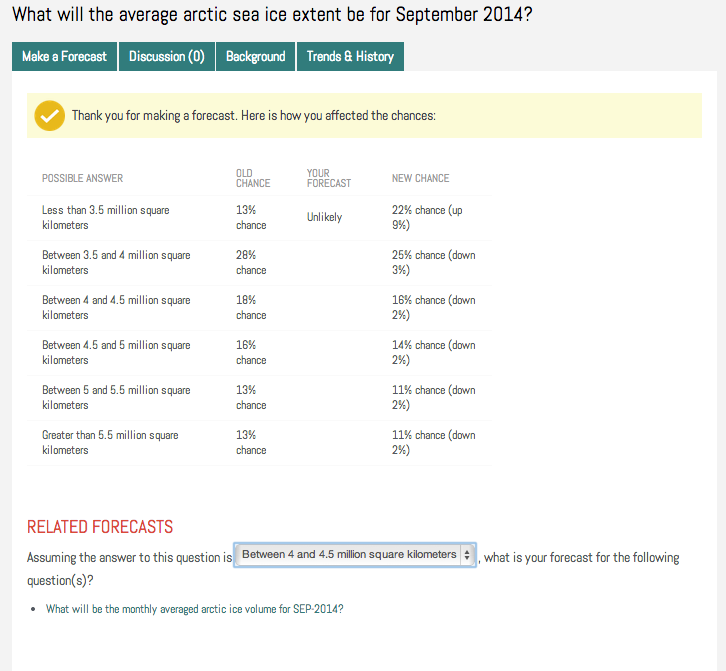
Select your answer to the related question, in this assumed scenario:
Repeat as you like with different scenarios (assumptions).
We hope to add links roughly weekly. Feel free to make suggestions via the Comments feature.
Sneak Peek: Sample Questions
The team is working very hard and we’re getting close to launch! We’re excited to share a sneak peek at some of the questions you will see…
Here’s an example:
What will the average arctic sea ice extent be for September 2014?
Some background: Passive microwave satellite data reveal that, since 1979, winter Arctic ice extent has decreased about 3 to 4 percent per decade. Arctic sea ice typically covers about 14 to 16 million square kilometers in late winter, and reaches a minimum of about 7 million square kilometers in mid-September. However, recent minima have all been below 6 million square kilometers, with 2012 at only 3.4 million square kilometers.
And, another question:
What percent of managed honey bee colonies in the US will be lost during the 2013-2014 winter?
Some background: Estimates of winter loss for managed honey bee (Apis mellifera) colonies are an important measure of honey bee health and productivity. Last year’s loss of bee colonies was 31.1% which is slightly higher than the previous 6-year average loss of 30.5 percent.
There will also be an opportunity to make forecasts in questions that are “linked” where the probability of something happening in one is affected by the other. For example, we’ll also ask:
How many billions of pounds of almond meat will be harvested in California in 2013?
This is linked to the previous question because almonds depend on bees for pollination; therefore bee colony health will affect agricultural yield, and may affect the amount of almonds harvested.
If you haven’t already, be sure to sign up at www.SciCast.org to be notified the week of December 2 when we launch. We’re also looking for people to help create and edit forecast questions! Send a note to [email protected] if you have questions you’d like to see on the site.
SciCast presented at the Northrop Grumman Information Systems’ University Symposium
Members of George Mason University’s C4I Center presented SciCast and two other C4I projects at the Northrop Grumman Information Systems’ University Symposium in McLean, VA this week. Dr. Charles Twardy (SciCast Principal Investigator) and Dr. Tod Levitt (SciCast Project Manager) discussed the SciCast market, and recruited potential question-writers and forecasters. There was steady interest and good discussion both of the public SciCast market and other potential uses of the technology. Our special thanks to Ludwig Tokatlian, Lolo Penedo, and the Future Technical Leaders program for the invitation.
Welcome to the SciCast blog!
SciCast is a government funded research project to forecast the outcomes of key issues in science and technology. SciCast is based on the idea that the collective wisdom of an informed and diverse group is often more accurate at forecasting the outcome of events than that of one individual.
Technically, SciCast is a prediction market. Prediction markets can be used to forecast the outcome of a wide variety of topics and are used today in large corporations and governments to understand the likelihood of meeting key performance metrics, quantify risks that may jeopardize operations, and better understand industry trends.
Unlike other prediction markets you may have heard of like Intrade or Inkling Markets, SciCast will create relationships between forecast questions that may have an influence on each other. For example, we may ask a question about the volume of sea ice in the Arctic in a given month. We may also ask a question about average temperature in this same locale or other influencing metrics. SciCast will learn from its participants how strong of a relationship these questions have to each other and will adjust their outcomes accordingly. This means if the SciCast participants forecast the average temperature will be higher in the Arctic, we’ll adjust the likelihood that the level of ice will decrease in that same time period.
SciCast will be a community-driven initiative. Participants will nominate questions and we will facilitate a process to get those questions published. Once a question is available, SciCast participants will wager their “SciCa$h” to make a forecast: the amount they wager depending on how much they want to influence the collective forecast. And unlike a survey, participants can change their mind at any time and increase or decrease their wager on a particular outcome. In this way, SciCast is a real-time indicator of what our participants think is going to happen.
After the answer to a question is known and made public, participants who answered correctly will be awarded SciCa$h based on their wager. The more correct forecasts a participant makes, the more SciCa$h they earn and the more influence they’ll have in other forecasts.
Our goal is to get thousands of participants from around the world. We’re currently reaching out to Professional Societies, Universities, and interest groups to solicit their participation. If you are part of an organization you think would like to participate, please let us know and we will introduce ourselves.
SciCast will be launched in early December, but you can pre-register now at http://scicast.org. If you’d like the SciCast participants to make forecasts on questions you’re interested in, you can also submit candidate questions now at http://signup.scicast.org/question_form.html



